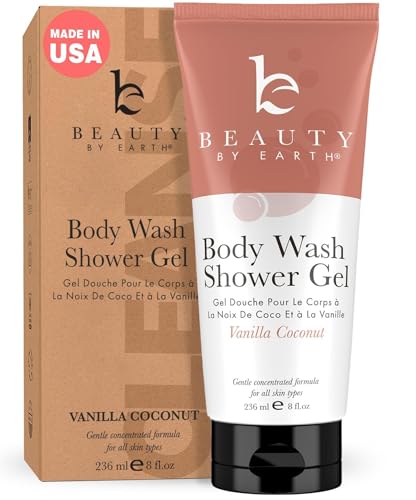
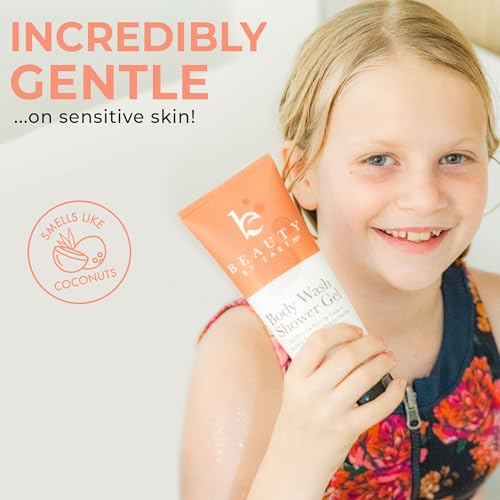
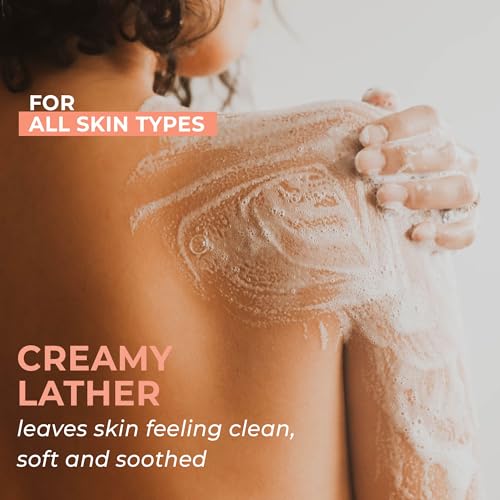
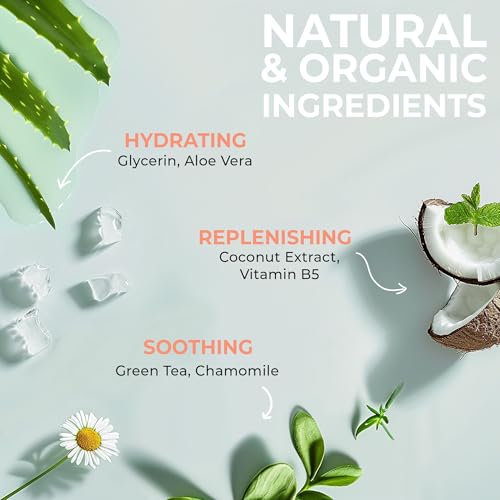
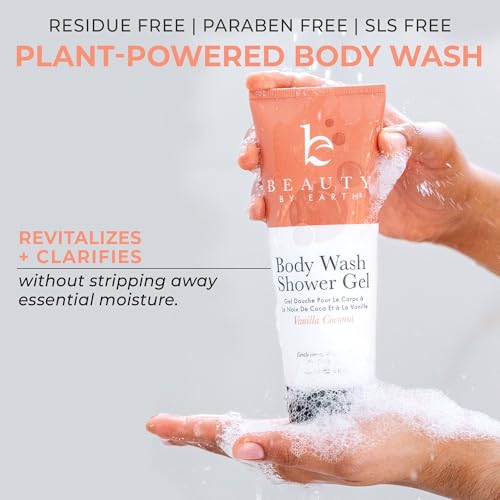
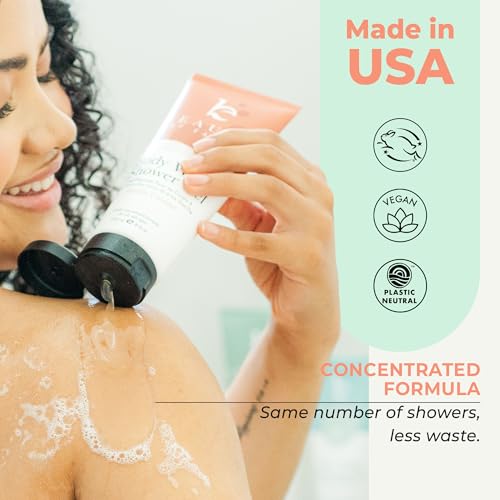
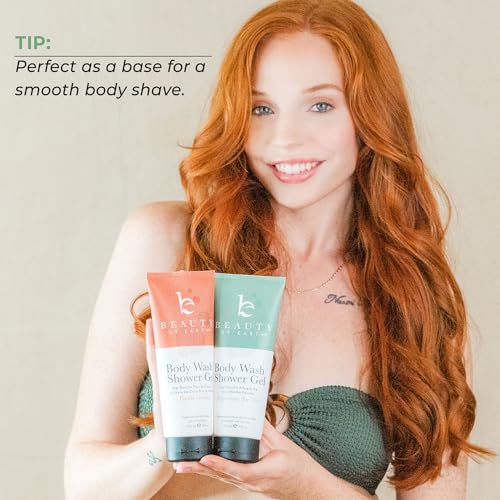
Vanilla Coconut Body Wash - Moisturizing, Gentle Clean for Sensitive Skin - 16oz


Citric Acid
Medium RiskCitric acid is an alpha hydroxy acid used in personal care products primarily for its role as a pH adjuster and natural preservative. It occurs naturally in citrus fruits and is commonly utilized in various formulations for its chelating properties and mild exfoliation benefits.
Sustai Insights
Citric acid offers functional benefits as an effective preservative and pH stabilizer, contributing to product longevity and stability. It is biodegradable and derived from renewable sources. Health risks are low, with minimal concerns regarding carcinogenicity, allergies, and reproductive toxicity. However, moderate use restrictions exist due to potential irritation at high concentrations. Environmental risks are limited, as citric acid is not known to accumulate in ecosystems. Regulatory agencies have no significant advisories against its use. Overall, it is assessed as a medium-risk ingredient, with safe usage practices recommended and alternatives available.
Hydrolyzed Quinoa
Low RiskHydrolyzed quinoa is a hydrolysate derived from quinoa grains, often used in cosmetic and personal care products for its moisturizing and conditioning properties. It is known for enhancing the texture and hydration of formulations, contributing to the overall performance of products.
Sustai Insights
Hydrolyzed quinoa offers functional benefits by acting as an effective moisturizer and conditioning agent in formulations, enhancing skin and hair texture. It is sustainably sourced and biodegradable, posing low health risks, including minimal concerns for carcinogenicity, allergies, and reproductive toxicity. Environmental risks are also low, with no significant pollutants or bioaccumulation observed. Regulatory assessments indicate no current restrictions. Overall, hydrolyzed quinoa presents a low-risk profile, making it a suitable ingredient in cosmetic applications.
Chamomilla Recutita (Matricaria) Flower Extract
Low RiskChamomilla recutita (Matricaria) flower extract is derived from the flower of the chamomile plant. It is commonly used in cosmetic products for its soothing properties and as an anti-inflammatory agent. This extract is valued for its potential to calm skin irritations and enhance overall skin appearance.
Sustai Insights
Chamomilla recutita (Matricaria) flower extract is recognized for its soothing and anti-inflammatory benefits, making it effective in skincare formulations. It is sustainably sourced and not associated with significant health risks, such as carcinogenicity or allergenic potential, resulting in a low-risk profile. Environmental concerns are minimal as it does not contribute significantly to pollution. Regulatory bodies impose few restrictions on its use, further supporting its safety. However, users should practice standard safety measures, particularly if they have known sensitivities. Overall, it is a low-risk ingredient with favorable attributes.
Vanilla Planifolia (Vanilla) Fruit Extract
Low RiskVanilla planifolia (vanilla) fruit extract is derived from the fruit of the vanilla plant. It is commonly used for its aromatic properties and as a flavoring agent in various products, including food, cosmetics, and personal care items.
Sustai Insights
Vanilla fruit extract offers functional benefits such as flavor enhancement and fragrance. It is sustainably sourced with low environmental impact and exhibits low risk for carcinogenicity and developmental toxicity. However, it may cause skin irritation in some individuals and has low to moderate allergenic potential. Regulatory bodies have not imposed significant restrictions, leading to an overall low risk assessment. Safe usage practices should be observed, and alternatives include synthetic vanillin for those seeking more stable options.
Xanthan Gum
Low RiskXanthan gum is a polysaccharide, a sugar-based compound produced by the fermentation of glucose or sucrose. It is commonly used as a thickening agent and stabilizer in various food and cosmetic products due to its ability to improve texture and prevent ingredient separation.
Sustai Insights
Xanthan gum serves effectively as a thickener and stabilizer, enhancing product texture and consistency. It is biodegradable and typically derived from renewable sources, supporting sustainability efforts. Health risks are minimal, with low concerns regarding carcinogenicity, allergies, and reproductive toxicity. Environmental impact is similarly low, posing no significant hazards. Regulatory agencies, including the FDA, regard it as safe for use, with no significant restrictions. Overall, xanthan gum is assessed as low risk, making it a suitable ingredient in formulations.
Propanediol
Low RiskPropanediol is a glycol compound commonly used in cosmetic and personal care products as a solvent, humectant, and skin-conditioning agent. It serves to enhance the texture and moisture retention of formulations, contributing to overall product efficacy.
Sustai Insights
Propanediol offers functional benefits such as effective moisture retention and improved product application. It is considered low-risk in terms of health concerns, with minimal associations with carcinogenicity, allergies, or reproductive toxicity. Environmentally, it has low pollutant potential and is not bioaccumulative. Regulatory bodies have not placed restrictions on its use. Despite concerns regarding enhanced skin absorption and potential endocrine disruption, the overall assessment indicates low risk. Safe usage practices should be followed, and alternatives like glycerin or other plant-based humectants can be considered.
Cucumis Sativus (Cucumber) Fruit Extract
Low RiskCucumis sativus (cucumber) fruit extract is derived from the fruit of the cucumber plant. It is commonly used in cosmetic formulations for its hydrating and soothing properties, often included in products aimed at providing moisture and calming effects to the skin.
Sustai Insights
Cucumis sativus fruit extract offers functional benefits such as hydration and soothing effects on the skin, contributing to the overall efficacy of cosmetic products. It is regarded as low risk with minimal health concerns, including low potential for carcinogenicity, irritation, or allergies. Environmental risks are also low, with no significant pollutant or bioaccumulation concerns. Regulatory bodies do not impose restrictions on its use, supporting its safety in cosmetics. Safe usage practices include ensuring proper formulation concentrations. Overall, this ingredient presents a low risk profile, making it a suitable choice for various cosmetic applications.
Cocos Nucifera Fruit Extract
Low RiskCocos Nucifera Fruit Extract is an extract derived from the fruit of the coconut palm, commonly used in cosmetic formulations for its moisturizing properties. It serves primarily as a skin conditioning agent, contributing to product texture and hydration.
Sustai Insights
Cocos Nucifera Fruit Extract offers functional benefits such as effective skin hydration and conditioning, with sustainable sourcing potential. Scientific assessments indicate low health risks, including minimal concerns for carcinogenicity, allergies, and reproductive toxicity. Environmental impacts are also low, with no significant bioaccumulation or pollution concerns. Regulatory bodies do not impose restrictions on its use, leading to an overall low-risk classification. Safe usage practices include patch testing for sensitive individuals. Alternatives like shea butter or other plant-based extracts may be considered for similar benefits.
Cocamidopropylamine Oxide
Low RiskCocamidopropylamine oxide is a tertiary amine derived from coconut oil, commonly used as a surfactant and foam booster in cosmetic and personal care products. It helps enhance the cleansing properties of formulations and improves the texture of products such as shampoos and body washes.
Sustai Insights
Cocamidopropylamine oxide offers functional benefits as an effective surfactant, enhancing product performance while being derived from renewable coconut sources, which supports sustainability. Health risks are minimal, with low concerns regarding carcinogenicity, allergies, or reproductive toxicity. Environmental risks are also low, with no significant pollutant potential noted. Regulatory assessments indicate no severe restrictions. Overall, this ingredient is considered low risk, promoting safe use in personal care formulations.
Sodium Cocoamphoacetate
Low RiskSodium cocoamphoacetate is an amphoteric organic compound derived from coconut oil. It functions primarily as a surfactant and cleansing agent in personal care products, aiding in the formulation of mild and effective products suitable for skin and hair applications.
Sustai Insights
Sodium cocoamphoacetate offers functional benefits as a mild surfactant, enhancing foaming and cleansing properties without significant irritation. It is considered low-risk for health concerns such as carcinogenicity, allergies, and reproductive toxicity. Environmental risks are minimal, as it is not bioaccumulative and is biodegradable. However, there may be slight irritation potential for sensitive individuals. Regulatory status is generally permissive, with no major restrictions noted. Overall, the ingredient is assessed to have a low risk profile, making it a suitable choice in formulations.
Lactobacillus Ferment
Low RiskLactobacillus ferment is an extract of the probiotic bacterium Lactobacillus, commonly used in cosmetic and personal care products for its potential skin health benefits. It is known for its role in fermentation processes, contributing to the formulation's efficacy as a skin conditioning agent.
Sustai Insights
Lactobacillus ferment offers functional benefits by improving skin hydration and barrier function, and it is often derived from sustainable sources. Health risks are low, with minimal concerns regarding carcinogenicity, allergies, or reproductive toxicity. Environmentally, it poses low risks, with no significant pollutant or bioaccumulation potential. Regulatory agencies do not impose restrictions on its use. Overall, the ingredient is assessed as low risk, and safe usage practices should be followed. Alternatives such as other probiotic extracts may be considered for similar benefits.
Caprylyl/ Capryl Glycoside
Low RiskCaprylyl/Capryl Glycoside is a surfactant derived from natural sources, primarily used in personal care and cosmetic products for its emulsifying properties. It helps to stabilize formulations and enhance cleaning efficacy while being gentle on the skin.
Sustai Insights
Caprylyl/Capryl Glycoside offers functional benefits as a mild surfactant and emulsifier, contributing to product stability without significant irritation. It is biodegradable and considered sustainably sourced. Health risks are low, with minimal concerns regarding carcinogenicity and developmental toxicity. Environmental impact is also low, as it does not accumulate in ecosystems. Regulatory assessments indicate no current restrictions. Overall, it presents a low risk profile, making it a suitable choice in formulations.
Lactobacillus
Low RiskLactobacillus is a genus of bacteria commonly used in food fermentation and as a probiotic in dietary supplements. It plays a significant role in maintaining gut health by aiding digestion and balancing intestinal flora. Lactobacillus is often found in yogurt and other fermented products.
Sustai Insights
Lactobacillus offers functional benefits as a probiotic, promoting gut health and enhancing digestion. It is generally regarded as safe, with low concerns regarding carcinogenicity, allergies, and reproductive toxicity. Environmental risks are minimal, and it is not restricted by major regulatory bodies. Overall, it is assessed as low risk, with safe usage practices supporting its incorporation in various products.
Vegetarian Glycerin
Low RiskVegetarian glycerin, also known as glycerol, is a colorless, odorless, and viscous liquid derived from plant sources. It is primarily used as a humectant, solvent, and emollient in various personal care products, helping to retain moisture and improve texture.
Sustai Insights
Vegetarian glycerin offers functional benefits as an effective humectant, promoting hydration and skin smoothness. It is biodegradable and typically sustainably sourced. Health risks associated with glycerin are low, with no significant concerns for carcinogenicity, allergens, or reproductive toxicity. Environmental risks are minimal, and it is not subject to major regulatory warnings. Overall, the risk level for this ingredient is low, making it a safe choice in formulations. Safe usage practices include ensuring proper concentrations in products, and alternatives such as propylene glycol exist but may have differing properties.
Aloe Barbadensis (Aloe Vera) Leaf Extract
Low RiskAloe vera leaf extract is produced from the succulent leaves of the Aloe barbadensis plant. It is commonly used in cosmetic formulations for its moisturizing and soothing properties, making it a popular ingredient in skincare and personal care products.
Sustai Insights
Aloe vera leaf extract offers several functional benefits, including hydration and skin soothing effects, which are well-supported by scientific literature. It is considered to have a low risk for common health concerns such as carcinogenicity, allergies, or reproductive toxicity. Environmentally, it poses minimal risks, with no significant pollutant potential or bioaccumulation reported. Regulatory bodies have not imposed major restrictions, although verified products should not contain certain contaminants. Overall, this ingredient is assessed as low risk, with safe usage practices and the availability of alternative soothing agents if desired.
Panthenol, D
Low RiskPanthenol, also known as provitamin B5, is a humectant commonly used in cosmetic and personal care products. It functions primarily as a moisturizer, enhancing skin hydration and improving the appearance of hair by imparting shine and softness.
Sustai Insights
Panthenol is effective in retaining moisture, thus providing functional benefits for skin and hair care products. It is generally recognized as safe, with low concerns regarding carcinogenicity, allergies, and developmental toxicity. However, potential cumulative exposure from multiple sources exists. Environmental risks are minimal, and it is not bioaccumulative. Regulatory bodies have not issued significant warnings; therefore, the overall risk level is assessed as low. For optimal use, it is recommended to follow product guidelines, and alternatives such as glycerin may also be considered for moisturizing effects.
Sodium Lauroyl Methyl Isethionate
Low RiskSodium lauroyl methyl isethionate is a surfactant and cleansing agent commonly used in cosmetic products. It is derived from natural sources and functions primarily to create lather and enhance the cleansing properties of formulations, making it effective in shampoos and body washes.
Sustai Insights
Sodium lauroyl methyl isethionate provides effective cleansing and lathering properties, making it beneficial in personal care products. It is considered biodegradable and has low allergenic potential, posing minimal health risks, including low concerns for carcinogenicity and irritation. Regulatory assessments indicate no significant restrictions, supporting its safe use. Environmental risks are minimal, with no evidence of bioaccumulation or ecotoxicity. Overall, the ingredient is assessed as low risk, with safe usage practices recommended. Alternatives include milder surfactants derived from plant sources.
Hydrolyzed Quinoa
Low RiskHydrolyzed quinoa is a hydrolysate derived from quinoa grains, often used in cosmetic and personal care products for its moisturizing and conditioning properties. It is known for enhancing the texture and hydration of formulations, contributing to the overall performance of products.
Sustai Insights
Hydrolyzed quinoa offers functional benefits by acting as an effective moisturizer and conditioning agent in formulations, enhancing skin and hair texture. It is sustainably sourced and biodegradable, posing low health risks, including minimal concerns for carcinogenicity, allergies, and reproductive toxicity. Environmental risks are also low, with no significant pollutants or bioaccumulation observed. Regulatory assessments indicate no current restrictions. Overall, hydrolyzed quinoa presents a low-risk profile, making it a suitable ingredient in cosmetic applications.
Chamomilla Recutita (Matricaria) Flower Extract
Low RiskChamomilla recutita (Matricaria) flower extract is derived from the flower of the chamomile plant. It is commonly used in cosmetic products for its soothing properties and as an anti-inflammatory agent. This extract is valued for its potential to calm skin irritations and enhance overall skin appearance.
Sustai Insights
Chamomilla recutita (Matricaria) flower extract is recognized for its soothing and anti-inflammatory benefits, making it effective in skincare formulations. It is sustainably sourced and not associated with significant health risks, such as carcinogenicity or allergenic potential, resulting in a low-risk profile. Environmental concerns are minimal as it does not contribute significantly to pollution. Regulatory bodies impose few restrictions on its use, further supporting its safety. However, users should practice standard safety measures, particularly if they have known sensitivities. Overall, it is a low-risk ingredient with favorable attributes.
Vanilla Planifolia (Vanilla) Fruit Extract
Low RiskVanilla planifolia (vanilla) fruit extract is derived from the fruit of the vanilla plant. It is commonly used for its aromatic properties and as a flavoring agent in various products, including food, cosmetics, and personal care items.
Sustai Insights
Vanilla fruit extract offers functional benefits such as flavor enhancement and fragrance. It is sustainably sourced with low environmental impact and exhibits low risk for carcinogenicity and developmental toxicity. However, it may cause skin irritation in some individuals and has low to moderate allergenic potential. Regulatory bodies have not imposed significant restrictions, leading to an overall low risk assessment. Safe usage practices should be observed, and alternatives include synthetic vanillin for those seeking more stable options.
Xanthan Gum
Low RiskXanthan gum is a polysaccharide, a sugar-based compound produced by the fermentation of glucose or sucrose. It is commonly used as a thickening agent and stabilizer in various food and cosmetic products due to its ability to improve texture and prevent ingredient separation.
Sustai Insights
Xanthan gum serves effectively as a thickener and stabilizer, enhancing product texture and consistency. It is biodegradable and typically derived from renewable sources, supporting sustainability efforts. Health risks are minimal, with low concerns regarding carcinogenicity, allergies, and reproductive toxicity. Environmental impact is similarly low, posing no significant hazards. Regulatory agencies, including the FDA, regard it as safe for use, with no significant restrictions. Overall, xanthan gum is assessed as low risk, making it a suitable ingredient in formulations.
Propanediol
Low RiskPropanediol is a glycol compound commonly used in cosmetic and personal care products as a solvent, humectant, and skin-conditioning agent. It serves to enhance the texture and moisture retention of formulations, contributing to overall product efficacy.
Sustai Insights
Propanediol offers functional benefits such as effective moisture retention and improved product application. It is considered low-risk in terms of health concerns, with minimal associations with carcinogenicity, allergies, or reproductive toxicity. Environmentally, it has low pollutant potential and is not bioaccumulative. Regulatory bodies have not placed restrictions on its use. Despite concerns regarding enhanced skin absorption and potential endocrine disruption, the overall assessment indicates low risk. Safe usage practices should be followed, and alternatives like glycerin or other plant-based humectants can be considered.
Cucumis Sativus (Cucumber) Fruit Extract
Low RiskCucumis sativus (cucumber) fruit extract is derived from the fruit of the cucumber plant. It is commonly used in cosmetic formulations for its hydrating and soothing properties, often included in products aimed at providing moisture and calming effects to the skin.
Sustai Insights
Cucumis sativus fruit extract offers functional benefits such as hydration and soothing effects on the skin, contributing to the overall efficacy of cosmetic products. It is regarded as low risk with minimal health concerns, including low potential for carcinogenicity, irritation, or allergies. Environmental risks are also low, with no significant pollutant or bioaccumulation concerns. Regulatory bodies do not impose restrictions on its use, supporting its safety in cosmetics. Safe usage practices include ensuring proper formulation concentrations. Overall, this ingredient presents a low risk profile, making it a suitable choice for various cosmetic applications.
Citric Acid
Medium RiskCitric acid is an alpha hydroxy acid used in personal care products primarily for its role as a pH adjuster and natural preservative. It occurs naturally in citrus fruits and is commonly utilized in various formulations for its chelating properties and mild exfoliation benefits.
Sustai Insights
Citric acid offers functional benefits as an effective preservative and pH stabilizer, contributing to product longevity and stability. It is biodegradable and derived from renewable sources. Health risks are low, with minimal concerns regarding carcinogenicity, allergies, and reproductive toxicity. However, moderate use restrictions exist due to potential irritation at high concentrations. Environmental risks are limited, as citric acid is not known to accumulate in ecosystems. Regulatory agencies have no significant advisories against its use. Overall, it is assessed as a medium-risk ingredient, with safe usage practices recommended and alternatives available.
Cocos Nucifera Fruit Extract
Low RiskCocos Nucifera Fruit Extract is an extract derived from the fruit of the coconut palm, commonly used in cosmetic formulations for its moisturizing properties. It serves primarily as a skin conditioning agent, contributing to product texture and hydration.
Sustai Insights
Cocos Nucifera Fruit Extract offers functional benefits such as effective skin hydration and conditioning, with sustainable sourcing potential. Scientific assessments indicate low health risks, including minimal concerns for carcinogenicity, allergies, and reproductive toxicity. Environmental impacts are also low, with no significant bioaccumulation or pollution concerns. Regulatory bodies do not impose restrictions on its use, leading to an overall low-risk classification. Safe usage practices include patch testing for sensitive individuals. Alternatives like shea butter or other plant-based extracts may be considered for similar benefits.
Cocamidopropylamine Oxide
Low RiskCocamidopropylamine oxide is a tertiary amine derived from coconut oil, commonly used as a surfactant and foam booster in cosmetic and personal care products. It helps enhance the cleansing properties of formulations and improves the texture of products such as shampoos and body washes.
Sustai Insights
Cocamidopropylamine oxide offers functional benefits as an effective surfactant, enhancing product performance while being derived from renewable coconut sources, which supports sustainability. Health risks are minimal, with low concerns regarding carcinogenicity, allergies, or reproductive toxicity. Environmental risks are also low, with no significant pollutant potential noted. Regulatory assessments indicate no severe restrictions. Overall, this ingredient is considered low risk, promoting safe use in personal care formulations.
Sodium Cocoamphoacetate
Low RiskSodium cocoamphoacetate is an amphoteric organic compound derived from coconut oil. It functions primarily as a surfactant and cleansing agent in personal care products, aiding in the formulation of mild and effective products suitable for skin and hair applications.
Sustai Insights
Sodium cocoamphoacetate offers functional benefits as a mild surfactant, enhancing foaming and cleansing properties without significant irritation. It is considered low-risk for health concerns such as carcinogenicity, allergies, and reproductive toxicity. Environmental risks are minimal, as it is not bioaccumulative and is biodegradable. However, there may be slight irritation potential for sensitive individuals. Regulatory status is generally permissive, with no major restrictions noted. Overall, the ingredient is assessed to have a low risk profile, making it a suitable choice in formulations.
Lactobacillus Ferment
Low RiskLactobacillus ferment is an extract of the probiotic bacterium Lactobacillus, commonly used in cosmetic and personal care products for its potential skin health benefits. It is known for its role in fermentation processes, contributing to the formulation's efficacy as a skin conditioning agent.
Sustai Insights
Lactobacillus ferment offers functional benefits by improving skin hydration and barrier function, and it is often derived from sustainable sources. Health risks are low, with minimal concerns regarding carcinogenicity, allergies, or reproductive toxicity. Environmentally, it poses low risks, with no significant pollutant or bioaccumulation potential. Regulatory agencies do not impose restrictions on its use. Overall, the ingredient is assessed as low risk, and safe usage practices should be followed. Alternatives such as other probiotic extracts may be considered for similar benefits.
Caprylyl/ Capryl Glycoside
Low RiskCaprylyl/Capryl Glycoside is a surfactant derived from natural sources, primarily used in personal care and cosmetic products for its emulsifying properties. It helps to stabilize formulations and enhance cleaning efficacy while being gentle on the skin.
Sustai Insights
Caprylyl/Capryl Glycoside offers functional benefits as a mild surfactant and emulsifier, contributing to product stability without significant irritation. It is biodegradable and considered sustainably sourced. Health risks are low, with minimal concerns regarding carcinogenicity and developmental toxicity. Environmental impact is also low, as it does not accumulate in ecosystems. Regulatory assessments indicate no current restrictions. Overall, it presents a low risk profile, making it a suitable choice in formulations.
Lactobacillus
Low RiskLactobacillus is a genus of bacteria commonly used in food fermentation and as a probiotic in dietary supplements. It plays a significant role in maintaining gut health by aiding digestion and balancing intestinal flora. Lactobacillus is often found in yogurt and other fermented products.
Sustai Insights
Lactobacillus offers functional benefits as a probiotic, promoting gut health and enhancing digestion. It is generally regarded as safe, with low concerns regarding carcinogenicity, allergies, and reproductive toxicity. Environmental risks are minimal, and it is not restricted by major regulatory bodies. Overall, it is assessed as low risk, with safe usage practices supporting its incorporation in various products.
Vegetarian Glycerin
Low RiskVegetarian glycerin, also known as glycerol, is a colorless, odorless, and viscous liquid derived from plant sources. It is primarily used as a humectant, solvent, and emollient in various personal care products, helping to retain moisture and improve texture.
Sustai Insights
Vegetarian glycerin offers functional benefits as an effective humectant, promoting hydration and skin smoothness. It is biodegradable and typically sustainably sourced. Health risks associated with glycerin are low, with no significant concerns for carcinogenicity, allergens, or reproductive toxicity. Environmental risks are minimal, and it is not subject to major regulatory warnings. Overall, the risk level for this ingredient is low, making it a safe choice in formulations. Safe usage practices include ensuring proper concentrations in products, and alternatives such as propylene glycol exist but may have differing properties.
Aloe Barbadensis (Aloe Vera) Leaf Extract
Low RiskAloe vera leaf extract is produced from the succulent leaves of the Aloe barbadensis plant. It is commonly used in cosmetic formulations for its moisturizing and soothing properties, making it a popular ingredient in skincare and personal care products.
Sustai Insights
Aloe vera leaf extract offers several functional benefits, including hydration and skin soothing effects, which are well-supported by scientific literature. It is considered to have a low risk for common health concerns such as carcinogenicity, allergies, or reproductive toxicity. Environmentally, it poses minimal risks, with no significant pollutant potential or bioaccumulation reported. Regulatory bodies have not imposed major restrictions, although verified products should not contain certain contaminants. Overall, this ingredient is assessed as low risk, with safe usage practices and the availability of alternative soothing agents if desired.
Panthenol, D
Low RiskPanthenol, also known as provitamin B5, is a humectant commonly used in cosmetic and personal care products. It functions primarily as a moisturizer, enhancing skin hydration and improving the appearance of hair by imparting shine and softness.
Sustai Insights
Panthenol is effective in retaining moisture, thus providing functional benefits for skin and hair care products. It is generally recognized as safe, with low concerns regarding carcinogenicity, allergies, and developmental toxicity. However, potential cumulative exposure from multiple sources exists. Environmental risks are minimal, and it is not bioaccumulative. Regulatory bodies have not issued significant warnings; therefore, the overall risk level is assessed as low. For optimal use, it is recommended to follow product guidelines, and alternatives such as glycerin may also be considered for moisturizing effects.
Sodium Lauroyl Methyl Isethionate
Low RiskSodium lauroyl methyl isethionate is a surfactant and cleansing agent commonly used in cosmetic products. It is derived from natural sources and functions primarily to create lather and enhance the cleansing properties of formulations, making it effective in shampoos and body washes.
Sustai Insights
Sodium lauroyl methyl isethionate provides effective cleansing and lathering properties, making it beneficial in personal care products. It is considered biodegradable and has low allergenic potential, posing minimal health risks, including low concerns for carcinogenicity and irritation. Regulatory assessments indicate no significant restrictions, supporting its safe use. Environmental risks are minimal, with no evidence of bioaccumulation or ecotoxicity. Overall, the ingredient is assessed as low risk, with safe usage practices recommended. Alternatives include milder surfactants derived from plant sources.
Experience the luxury of our Vanilla Coconut Natural Shower Gel Body Wash, crafted in the USA with organic ingredients to pamper your skin. This gentle yet effective body wash is perfect for all skin types, especially sensitive skin, ensuring a nourishing cleanse with every use.
- Gentle Cleanse: This body wash is formulated with pure, natural ingredients like Aloe Vera and Coconut Extract, effectively removing impurities while being soft on the skin.
- Hydrating Formula: Enriched with high-quality botanicals, it leaves skin feeling soft and hydrated, making it ideal for daily use.
- Sensitive Skin Friendly: Free from parabens, sulfates, and artificial fragrances, this body wash ensures a relaxing shower experience without harsh chemicals.
- Family Safe: Suitable for everyone, this non-toxic body wash provides a clean, soothing wash for both women and children.
- Support Small Business: Every purchase helps support our commitment to quality and customer satisfaction, reinforcing ethical practices in personal care.
Subscribe & Save with Sustai
- Best Price Guarantee: Always enjoy the lowest prices on sustainable home essentials.
- No Surprises: We’ll notify you before shipping. No hidden fees, ever.
- You’re in Charge: Change, pause, or cancel your subscription anytime with ease.
- Eco-Friendly Deliveries: Our grouped shipments mean less packaging and lower emissions.
Join us on a sustainable journey. Special offers for a limited time! Prices and promotions may change.
Recommended Products
Experience the luxury of our Vanilla Coconut Natural Shower Gel Body Wash, crafted in the USA with organic ingredients to pamper your skin. This gentle yet effective body wash is perfect for all skin types, especially sensitive skin, ensuring a nourishing cleanse with every use.
- Gentle Cleanse: This body wash is formulated with pure, natural ingredients like Aloe Vera and Coconut Extract, effectively removing impurities while being soft on the skin.
- Hydrating Formula: Enriched with high-quality botanicals, it leaves skin feeling soft and hydrated, making it ideal for daily use.
- Sensitive Skin Friendly: Free from parabens, sulfates, and artificial fragrances, this body wash ensures a relaxing shower experience without harsh chemicals.
- Family Safe: Suitable for everyone, this non-toxic body wash provides a clean, soothing wash for both women and children.
- Support Small Business: Every purchase helps support our commitment to quality and customer satisfaction, reinforcing ethical practices in personal care.

You can have at most 2 Sustainable Steals products in your cart
Customer Reviews
Customers’ View
Customers appreciate the gentle cleansing and moisturizing properties of this body wash, stating it effectively cleans without irritating sensitive skin. Many users highlight the refreshing scent, with comments like, "The smooth texture and gentle smell is perfect for a morning shower." The product's natural ingredients, including aloe vera and green tea, resonate well with environmentally conscious consumers, who feel good about using clean, organic components. While there are mixed opinions on its lather and value for money, the overall sentiment is positive, as many find it leaves their skin feeling soft and hydrated. Overall, customers find this body wash both effective and aligned with their sustainable lifestyle.
AI-generated from the text of customer reviewsThis product has no reviews yet.





